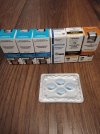Oxymetholone is a powerful oral anabolic steroid derived from dihydrotestosterone. More specifically, it is a close relative of methyldihydrotestosterone (mestanolone), differing only in the addition of the 2-hydroxymethylene group. This creates a steroid with significantly different activity than mestanolone, so it is very difficult to make a comparison between the two. For starters, oxymetholone is a very powerful anabolic hormone. Dihydrotestosterone and mestanolone are very weak in this regard because these molecules are not very stable in a high enzyme (3-alpha-hydroxysteroid dehydrogenase) muscle tissue environment. Oxymetholone, on the other hand, remains highly active here, as evidenced by standard animal tests showing significantly higher anabolic activity than testosterone or methyltestosterone. Such tests show that oxymetholone's androgenicity is also very low (1 /4 to 1 /7 of its anabolic activity), although actual results in humans show it to be much higher.
Oxymetholone is considered by many to be one of the most potent steroids available. A beginner experimenting with this steroid is likely to gain 20 to 30 pounds of weight, and this can often be achieved within 6 weeks of use. This steroid causes severe water retention, so much of this gain will come from water weight. Although the sleek appearance that results from water retention is often not attractive, it can help greatly in increasing size and strength. Muscles become fuller, contract better and gain a level of protection in the form of extra water retained in and around the connective tissues. This provides more elasticity and, one would think, reduces the likelihood of injury when lifting weights. It should be noted, however, that very rapid weight gain can put excessive strain on the connective tissues. Breast muscle and biceps tissue tears are commonly associated with heavy lifting, while weight gain on steroids and oxymetholone is common. Gaining weight too quickly can lead to dire consequences.
History:
Oxymetholone was first described in 1959.The drug was released in the United States as a prescription drug in the early 1960s and sold under the trade names Anadrol-SO (Syntex) and Androyd (Parke Davis & Co.). The drug was developed by Syntex, and the patent rights to it were retained until they expired many years later. The drug was originally approved for use in conditions where anabolic action was needed. Indications for use were geriatric weakness, chronic underweight, preoperative and postoperative lean body mass preservation, recovery from infections, gastrointestinal disease, osteoporosis, and general catabolic conditions. The recommended dose for these cases was usually 2.5 mg three times daily. The drug originally came in 2.5 mg, 5 mg, or 1O mg tablets.
Despite the many potential therapeutic uses or the strong anabolic activity of the drug, the FDA soon strictly narrowed the scope of oxymetholone. By the mid-1970s, the drug was approved by the FDA only for the indicated treatment of anemia characterized by inadequate red blood cell production. Stimulation of erythropoiesis is an effect common to almost all anabolic steroids, which tend to increase red blood cell concentrations. Oxymetholone, however, has seemed quite reliable in this respect.This has led to its adoption for this relatively new medical use, and to the introduction of the higher (5O mg) dosage in the updated Anadrol-50 product needed for a stronger effect.
However, the Parke Davis drug was not brought up to the higher dosage and was discontinued.
Several new therapies for anemia have emerged in recent years, most notably Epogen (recombinant erythropoietin) and related erythropoietic peptides. These drugs directly mimic the body's natural red blood cell-producing hormone and as such provide a much more targeted form of therapy, with fewer side effects unrelated to the use of strong androgens. Although Anadrol was once considered an effective drug for this purpose, its sales are now declining. Financial disinterest led Syntex to discontinue production of Anadrol 50 in the United States in 1993, and around the same time they decided to discontinue the drug in several foreign countries. Plenastril from Switzerland and Austria was discontinued; it was soon followed by Oxytozone from Spain. In the mid-1990s, many athletes feared that Oxymetholone had left the market for good.
In July 1997 Syntex sold all rights to Anadrol-50 in the United States, Canada, and Mexico to Unimed Pharmaceuticals. In 1998, Unimed reintroduced Anadrol-50 to the U.S. market, this time for patients with HIV/AIDS. Patients with HIV usually suffer from anemia, often caused by the disease itself, by opportunistic infections, or by antiretroviral drugs used to treat the disease. Anemia in patients with HIV is usually associated with impaired red blood cell production in the bone marrow, which is an FDA-approved indication for oxymetholone. In addition, oxymetholone has shown great promise in HIV-related debilitation studies. Unimed soon began trials using Anadrolone to treat HIV wasting syndrome, and continued research on its use to treat conditions such as chronic obstructive pulmonary disease and lipodystrophy (a disorder characterized by selective loss of body fat, insulin resistance, diabetes, high triglyceride levels and fatty liver).
Since the early 2000s, the production of oxymetholone has been controversial, especially in the United States. The intellectual property for Anadrol-50 has changed hands several times: first it was sold by Solvay/Unimed to Alaven Pharmaceutical, then it was taken over by Meda during the company's acquisition, and most recently it was sold again to Mylan Specialty (2012). In all cases, the drug retained its narrow FDA-approved therapeutic use for the treatment of anemia with red blood cell deficiency. The pharmacy cost was extremely high, eliminating the possibility of significant diversion. Oxymetholone is still available outside the United States, although it is mostly sold in countries where steroids are less strictly regulated. Syntex appears to have removed itself from the market worldwide, ceasing production or transferring the license to other companies when possible.





